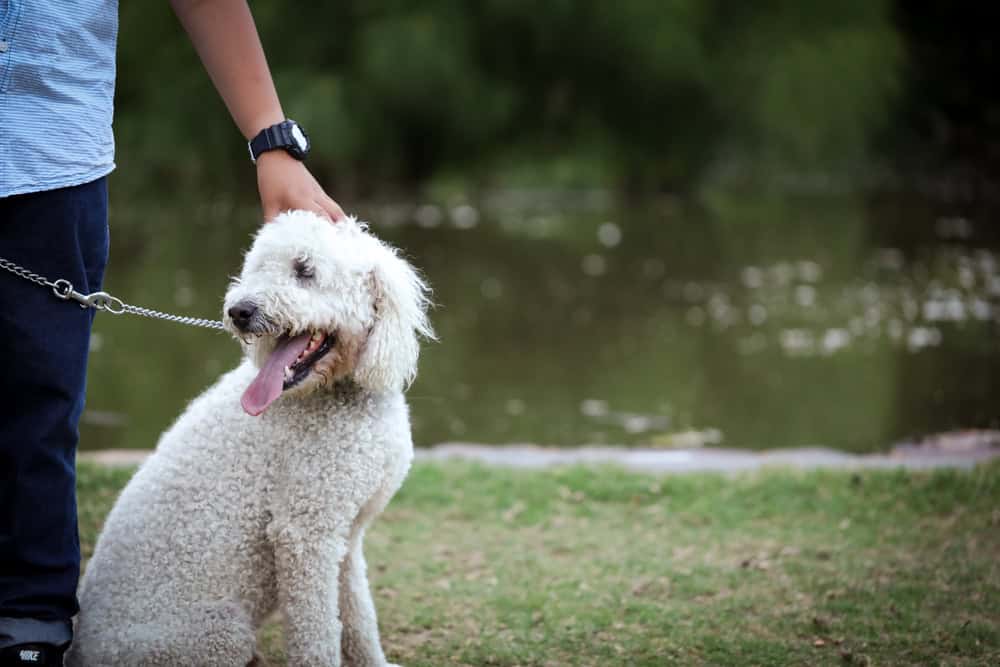Two breeds have infamously topped the most popular breed list in America for years; the Golden Retrievers and the Poodle, so it’s no surprise that eventually the two were crossbred to create the popular Goldendoodle.
Goldendoodles are quickly becoming one of the most popular breeds of dogs. They are an excellent family dog thanks to their excellent temperaments. They love their family wholeheartedly thanks to the Golden Retriever friendliness and Poodle loyalty. They get along with family members of any age, and tend to be easier on allergies than other dogs, which is great for that allergic husband or wife, or someone with specific allergen needs.
They also make excellent service dogs. Service dogs must be intelligent, well-focused and friendly, all of which are traits a Doodle possesses. They have all the great characteristics of both their parent breeds, are a great size for balance support, are motivated in task training, respond well to a trainer, and love people. It’s no surprise they are appearing more and more in service dog or psychiatric service animal is not to be confused with an emotional support dog! A service dog training programs, in nursing homes, or assisting students.
What are Service Dogs?

The definition of a service dog according to the U.S. Department of Justice as “dogs that are individually trained to do work or perform tasks for people with disabilities.” This is a very broad definition, and there is some grey area, so we will discuss the specifics of a companion dog vs. a service dog later to answer any questions. Laws can vary state to state and task training is very different for each different disability, which we will delve into more later.
Luckily, more legislation was provided on the definition of service dogs. The Americans with Disabilities Act (ADA) of 1990 gave a more specific definition for service dogs: “dogs that are individually trained to do work or perform tasks for people with disabilities. Examples of such work or tasks include guiding people who are blind, alerting people who are deaf, pulling a wheelchair, alerting and protecting a person who is having a seizure, alerting owners to a panic attack, reminding a person with mental illness to take prescribed medications, calming a person with Post Traumatic Stress Disorder (PTSD) during an anxiety attack, or performing other duties.”
Types of Service Dogs
There are many different types of assistance dogs for different disabilities. While some disorders are physical, some are mental. Service dogs help their owner with many things, including balance issues, improving mental state, alerting to low blood pressure, alerting them to a seizure, etc. Let’s go over the different types of assistance dogs.
Service dog: A service dog is the most common type and is the broadest category. A service animal can help with many things, but in this category, it is most often pups offering assistance with physical disabilities or impairments. These dogs are a great addition to their owners’ lives and become a beloved family member that makes their home life much easier.
- Guide dogs: These dogs are also known as seeing-eye-dogs and help people with vision loss navigate the world. A guide dog will help their handler avoid obstacles, open doors, maintain a steady piece, board public transport, etc.
- Hearing dogs: These talented pups assist their deaf handlers in a world that is full of noise. They are trained to help their owners receive vital cues of sounds they cannot hear themselves. These cues include smoke or fire alarms, doorbells, door knocking, phones, alarm clocks, and even the person’s name. They will guide their owner to the sound or to safety, depending on the situation.
- Medical alert dogs: These service dogs help owners suffering from seizures or epilepsy prepare for an upcoming seizure episode and keep them safe during it. Another type of service dog under this category is a diabetic assistance dog, who helps alert their owner when their blood sugar is low or can seek medical assistance if necessary.
- Mobility assistance dogs: A mobility assistance dog is a type of service dog that helps humans with spinal injuries, leg injuries, or any injury that makes walking, standing or balancing difficult. These are typically larger breed dogs since they provide balance support for their handler. They help their human stay standing, open doors, walk, retrieve items, etc.
Psychiatric service dog: This special service dog assists people with mental disabilities or mood disorders. They have all the same rights as all the above mentioned service dogs, but undergo specialized service dog task training to help their owners with mental needs. Some examples of this could be retrieving medication, providing comforting touches, finding a quiet place for their owner, etc. These service dogs help with mental health issues rather than mobility issues. Someone who suffers from depression, anxiety attacks, PTSD or other mental disabilities could greatly benefit from a psychiatric service dog.
Click the below video to learn more about psychiatric service dogs.
Therapy dog: A therapy dog is not a service dog, but instead a dog that provides emotional support and comfort to people in stressful situations. This is often a hospital or nursing home, but can also be schools, natural disaster sites, etc. They are not service animals as they don’t perform specific tasks for people with disabilities, but they do undergo specialized training, including passing an American Kennel Club Good Citizen test, then visit anyone who could need comfort. They have a home and are a pet at the end of the day.
Emotional support animal: An emotional support animal is a companion animal that provides emotional support to their owner. They do not undergo any special training, and are not a service animal. They do not provide assistance to any other people besides their owner, and mainly stay at home or can sometimes accompany their handler during travel. Any animal can become an emotional support animal with a doctor’s note, but they do not have the same rights as service dogs or assistance dogs. Newer laws have become more strict with emotional support animal’s ability to fly with their owners.
Emotional Support Dog vs. Psychiatric Service Dog: What’s the Difference?

While both emotional support dogs and psychiatric service dogs provide emotional and mental support to their owner, only one is a recognized service animal, and that’s a psychiatric service dog. These dogs undergo specialized task training and have federally protected rights, such as the right to accompany their owner anywhere, including businesses, schools, non-pet friendly housing, on airplanes, etc. The important part here is that through a trainer or program, they learn specific tasks to help their owner. Emotional support dogs and others do not go through task training, so they are pets. To get a psychiatric service dog, you must be diagnosed with a disability and prescribed a service dog who undergoes vigorous training to support you.
An emotional support dog only requires a letter of recommendation from a doctor. They are a pet who offers mental and emotional benefits to their owner, which can be very helpful, but they can’t accompany their owners in public places, nor do they have access on flights, in schools, etc. and have no federally protected rights. Dogs and cats are the most common types of ESAs, but any animal has the chance to become an ESA with a doctor’s note.
In modern days, emotional support animals are a hot topic due to their loose regulations. Some lack vaccinations, aren’t the proper age, or people pay high prices for a form that is fake to recognize their pet as an emotional support animal or even worse, a service dog. It is very important to recognize the difference between these two types of dogs. Service dogs wear vests to set themselves apart, as they have a very important job and should be recognized as working dogs. Pretending a dog is a service dog is actually illegal in 20+ states and is very damaging to service dogs’ reputations. It makes life for people with disabilities much harder, and poses a challenge to service dog owners, making the conditions of service dogs worse.
Why Goldendoodles?
Now that we know more about service dogs, why are Goldendoodles becoming so popular? It’s no surprise, as they are two popular breeds combined, but there is also another factor: Goldendoodles are hypoallergenic.
There is a fair amount of discourse over Goldeendoodles and their hypoallergenic coat. According to experts, the truth is no dog is 100% hypoallergenic. Allergies are a complex system and all pets have dander. This is what people are allergic to, not fur or saliva. When a dog sheds, flakes of dead skin also come off, which is the dander we speak of. This is what triggers allergens. Dander becomes more and more prominent as puppies grow up. Puppies’ themselves actually have a pretty low amount of dander and expel more of it as they grow.
What sets the Goldendoodle apart is their lack of shedding. While no dog is 100% hypoallergenic, and allergies are all unique, Goldendoodles do shed less than the average dog, which could reduce dander. They will still require routine grooming, in fact, they may need more grooming than an average dog, but their hair is tightly wound (thanks Poodle genetics!), which makes it more resistant to breaking or falling off to spread dander.
10 to 20% of Americans suffer from pet allergies, and this includes the disabled population. People with disabilities rely on service dogs to help them with balance issues, or to act as diabetic alert dogs, assistant dogs, and much more. If they are allergic to their dog, the companion can cause more harm than good. This is why a “hypoallergenic” breed, like a Doodle, can be a great addition for someone who suffers from dog allergies. They can still interact with their Goldendoodle and not suffer extreme allergies.
The Makeup of a Goldendoodle
As we mentioned, and as their name implies, Goldendoodles are the combination of a Golden Retriever bred with a Poodle. This is almost always a standard Poodle, which is the larger and original Poodle.
This combination takes the best characteristics from both breeds and creates an amazing mix, full of all the loveable personality traits and the size we’ve all come to love . The Goldendoodle stands around 20 to 24 inches tall at the shoulder, and weighs between 50 and 90 pounds. On average, they live between 10 and 15 years and are overall fairly healthy, though they are predisposed to hip issues due to their size. A Goldendoodle has a curly coat that is luxuriously soft and has multiple coat colors, including black, chocolate, red, white, apricot, cream and brown.
Golden Retrievers as Service Dogs
The Goldendoodle was first introduced in the 1990’s as a solution for families with allergies who still wanted a pet. In fact, many families wanted a Golden Retriever, but they are notorious shedders. Over the years, the art of breeding this breed became more refined. Now, with proper breeding, there is a 90% chance of the non-shedding gene passing on. It’s important to remember the Goldendoodle isn’t exactly a breed, but a hybrid of two other breeds, but for simplicity sake, we will refer to them as a breed.
The Goldendoodle’s beauty isn’t what sets them apart, but their personality. They are very affectionate, friendly, obedient, active, and playful. This playfulness can lead to a bit of mischievousness, but when trained properly, they can be highly obedient.
The Goldendoodle is a fairly quiet dog, and responds well to new situations and environments. As puppies, they are curious and friendly, and they tend to keep a certain level of puppy about them throughout their entire life. They are very energetic, and need room to run and play, as well as mental stimulation. They are also highly social and very friendly to other dogs and really, all other animals and people too!
Goldendoodles aim to please, and love to befriend people, so they are a great candidate for a service dog. The Poodle is a very intelligent breed, and the Golden Retriever is very social, so the combination of the two is a very trainable, lovable dog who aims to please and help, making them a great service dog.
How to Get a Goldendoodle Service Dog

Are you interested in having a Goldendoodle service dog? Good news, Goldendoodles are now very commonly bred for this sole purpose. They begin training as a puppy and are trained to be excellent service companions. Service dog training programs are welcoming Goldendoodles with open arms due to their great personality and size.
First, you’ll want to make sure you are able to receive a service dog. Service dogs are only given to people with disabilities that hinder their quality of life. For a psychiatric service dog, you must consult with a licensed mental health professional. This is the only legitimate way to acquire a service dog. For physical disabilities, you must consult with a doctor in your area.
If they recommend a service dog, the next step is finding a service dog for you. Look at rescues in your local area to see if they have any Golden Retrievers or Golden mixes available, or you can purchase a Golden from a breeder or service dog organization. If you adopt one or purchase one from a breeder, you will want to work with a service dog trainer or service dog program training to make sure your pooch becomes the best assistance dog possible.
Look for reputable breeders that stick to the breeds’ standards. This is the best way to ensure you get a Goldendoodle that is healthy and has all the characteristics we love about the popular breed.
Conclusion
Now you see why Goldendoodles are such a beloved breed, not only as pets, but also as service animals. They take the best things from two of the most popular dog breeds and create a beautiful, loyal, playful companion that is eager to service.
Are you looking for a psychiatric service dog?
Here at CertaPet, we can help. CertaPet is an online telehealth platform that improves access to mental health care in the U.S. with a focus on providing services to individuals who are seeking animal assisted interventions as part of their treatment plan.
We are currently coordinating with dog trainers who specialize in the service animal space and who will soon work in tandem with our network of licensed mental health professionals to make the process of getting and training a psychiatric service dog affordable, convenient, and hassle-free. We’ll have more information available soon about our Psychiatric Service Dog Training options. In the meantime, you can take our FREE pre-screening below to see if you qualify for a PSD!
Meta: Are you looking for a Goldendoodle service dog? Learn all about the breed and their characteristics and how to adopt one near you to become your service animal.
FAQs
Why do Goldendoodles make good service dogs?
Goldendoodles make excellent service dogs thanks to their size, friendly demeanor, eagerness to learn, puppy-like personality, and their hypoallergenic nature.
How do I get a psychiatric service dog?
First, you must consult with a mental health professional to see if you qualify. If you are diagnosed with a mental disability, you will begin your search for a dog and begin training
Where can I get a Goldendoodle?
You can adopt a Goldendoodle from your local shelter, or research reputable breeders in your area. Service dog organizations are also using Goldendoodles more and more!
